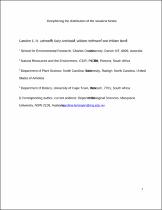JavaScript is disabled for your browser. Some features of this site may not work without it.
- ResearchSpace
- →
- Research Publications/Outputs
- →
- Journal Articles
- →
- View Item
| dc.contributor.author |
Lehmann, CER

|
|
| dc.contributor.author |
Archibald, SA

|
|
| dc.contributor.author |
Hoffmann, WA

|
|
| dc.contributor.author |
Bond, WJ

|
|
| dc.date.accessioned | 2011-06-27T10:23:14Z | |
| dc.date.available | 2011-06-27T10:23:14Z | |
| dc.date.issued | 2011-07 | |
| dc.identifier.citation | Lehmann, CER, Archibald, SA, Hoffmann, WA, et al. 2011. Deciphering the distribution of the savanna biome. New Phytologist, Vol. 191(1), pp. 197–209 | en_US |
| dc.identifier.issn | 0028-646X | |
| dc.identifier.uri | http://onlinelibrary.wiley.com/doi/10.1111/j.1469-8137.2011.03689.x/full | |
| dc.identifier.uri | http://hdl.handle.net/10204/5068 | |
| dc.description | Copyright. 2011 Wiley-Blackwell. This is a pre print version of the work. The definitive version is published in New Phytologist, Vol. 191(1), pp. 197–209 | en_US |
| dc.description.abstract | We aimed to identify the limits of savanna across Africa, Australia and South America. We based our investigation on the rich history of hypotheses previously examined; that the limits of savanna are variously determined by rainfall, rainfall seasonality, soil fertility and disturbance. We categorized vegetation on all continents as “savanna” (open habitats with a C4 grass layer) or “not savanna” (closed habitats with no C4 grass layer) and used a combination of statistical approaches to examine how savanna presence varied as a function of five environmental correlates. Savanna presence is constrained by effective rainfall and rainfall seasonality. Soil fertility is regionally important, although the direction of its effect changes relative to rainfall. We identified three continental divergences in the limits of savanna that could not be explained by environment. Climate and soils do not have a deterministic effect on the distribution of savanna. Over the range of savanna, some proportion of the land is always “not savanna”. We reconciled previous contradictory views of savanna limits by developing a new conceptual framework for understanding these limits by categorizing environmental factors into whether they have a positive or negative effect on woody growth and the frequency of disturbance. | en_US |
| dc.language.iso | en | en_US |
| dc.publisher | Wiley-Blackwell Publishers | en_US |
| dc.relation.ispartofseries | Workflow;6658 | |
| dc.subject | C4 grasses | en_US |
| dc.subject | Forest | en_US |
| dc.subject | Flammability | en_US |
| dc.subject | Alternate stable states | en_US |
| dc.subject | Fire | en_US |
| dc.subject | Herbivory | en_US |
| dc.title | Deciphering the distribution of the savanna biome | en_US |
| dc.type | Article | en_US |
| dc.identifier.apacitation | Lehmann, C., Archibald, S., Hoffmann, W., & Bond, W. (2011). Deciphering the distribution of the savanna biome. http://hdl.handle.net/10204/5068 | en_ZA |
| dc.identifier.chicagocitation | Lehmann, CER, SA Archibald, WA Hoffmann, and WJ Bond "Deciphering the distribution of the savanna biome." (2011) http://hdl.handle.net/10204/5068 | en_ZA |
| dc.identifier.vancouvercitation | Lehmann C, Archibald S, Hoffmann W, Bond W. Deciphering the distribution of the savanna biome. 2011; http://hdl.handle.net/10204/5068. | en_ZA |
| dc.identifier.ris | TY - Article AU - Lehmann, CER AU - Archibald, SA AU - Hoffmann, WA AU - Bond, WJ AB - We aimed to identify the limits of savanna across Africa, Australia and South America. We based our investigation on the rich history of hypotheses previously examined; that the limits of savanna are variously determined by rainfall, rainfall seasonality, soil fertility and disturbance. We categorized vegetation on all continents as “savanna” (open habitats with a C4 grass layer) or “not savanna” (closed habitats with no C4 grass layer) and used a combination of statistical approaches to examine how savanna presence varied as a function of five environmental correlates. Savanna presence is constrained by effective rainfall and rainfall seasonality. Soil fertility is regionally important, although the direction of its effect changes relative to rainfall. We identified three continental divergences in the limits of savanna that could not be explained by environment. Climate and soils do not have a deterministic effect on the distribution of savanna. Over the range of savanna, some proportion of the land is always “not savanna”. We reconciled previous contradictory views of savanna limits by developing a new conceptual framework for understanding these limits by categorizing environmental factors into whether they have a positive or negative effect on woody growth and the frequency of disturbance. DA - 2011-07 DB - ResearchSpace DP - CSIR KW - C4 grasses KW - Forest KW - Flammability KW - Alternate stable states KW - Fire KW - Herbivory LK - https://researchspace.csir.co.za PY - 2011 SM - 0028-646X T1 - Deciphering the distribution of the savanna biome TI - Deciphering the distribution of the savanna biome UR - http://hdl.handle.net/10204/5068 ER - | en_ZA |






